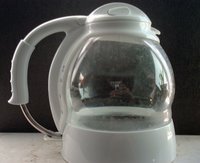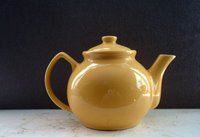Is a theory like a design?

 Clearing up some loose ends on verisimiltude led as a previous post shows, to Popper's Objective Knowledge, and questions of theory.
Clearing up some loose ends on verisimiltude led as a previous post shows, to Popper's Objective Knowledge, and questions of theory.Using a borrowed kettle for a few days while getting around to buying a new one, two and two added up to three - or five - and there was a set of what I thought might be analogies between Theory and Design. This came from a desire to have a simple fool-proof way of explaining what a theory was using a much simpler idea.
I guess its not right at all, but the desire to describe what arrived is greater than the desire not to be publicly ridiculed. In essence, I haven't a clue what I am suggesting but would be grateful for some feedback.
Theory = > Evidence
Design = > Object (implementation)
As soon as I used the kettle for the first time, I realised, though it is good looking, it was a poor design in practice. (1) the spout was too small, in the wrong place, and would not pour properly. (2) The relationship of the handle to the spout made it hard to pour: the ergondynamics all wrong.
Looking around the room for a good pourer - the classic tea pot - to compare with the design and functionality of the glass kettle, I saw by picking up the tea pot how easy it was to pour, with no strain on the arm.
The glass kettle is a beautifully designed object, but the functions are subsumed to its looks. Overall, it is a failed design because it is an aesthetic rather than a functional item. It just doesn't work as a kettle, in the water pouring sense, even though it heats water perfectly well.
At this point I oought to add that I have been doing a little reading: theory described as a set of sub-hypotheses fits quite well with the objectives any design. (all coloured writing has been added the next day)
Design is not a strict analogue of theory. Though in practice the way a design succeeds is similar to the way a theory does and is a way of explaining in simple, concrete terms (a) what a theory is [the wiki entry deals with the etymology of the word and one of the original meaning s of thw word in Greek theatre], (b) how it achieves virisimilitude.
There are elements of the concept of theory in the concept of design. The Classic tea pot is a very good pourer and looks good. Whatever went into the design (the principles that apply for pouring devices such as kettles and tea pots) will always give good pouring and and allow the arm to work efficiently without strain on muscles, tendons and ligaments). Of course, we are talking Kettles and tea-pots a bit like The Mad Hatter's Tea Party, but go with the flow.
A failed design is like a failed theory.
Here parts may be true because the hypotheses are sufficient to the task/ some but not all the design elements work in practice.
Plenty of people will have this type of kettle and be wondering why I think it won't pour. The answer is simple: it is pefectly good at pouring from full or half-full, but a cup or two, for a cup or two, is where the design falls apart. The reason this has come about can only be explained from the designer's-eye point of view. The kettle can't have been mass produced without a thoroughly check of its pouring ability. So the only conclusion for the cup or two, is no one tried to pour with only a few hundred c.c.s in the bottom of the kettle before the decision was made to o.k. the design. If they had they would have experienced the problems described. So, in other words this is a full-type kettle, not a generic pour kettle.
The same goes for a theory: most important, when devising one, to make sure the equivalent of the 'quarter-full kettle pouring problem' is avoided! It highlights the need for experiments beforehand.
Wiki: theory
In scientific usage, a theory does not mean an unsubstantiated guess or hunch, as it often does in other contexts. A theory is a logically self-consistent model or framework for describing the behavior of a related set of natural or social phenomena, which originates from and/or is supported by experimental evidence
A design is based on prior knowledge too, though more and more designs seem as if they are not. This may be explained partly by the design techniques used. I once saw on TV a telephone designed on computer, the designs sent to a factory in Asia and the samples in different colours made within days. No one seemed to be trying them out in various ways to see if they worked in such simple features as where the wires attached to the base and how easy the handset fell off. Later I bought one very much the same and have never been able to keep the phone flat on the table because of the wires and the hand set falls off its cradle very easily. Thousands of phone designers before recognised a wire attached to the side or back was the simplest way, but the more modern flatter profile requires (for some reason to do with electronics probably) otherwise.
Its over to you. Is a theory like a design?
P.S.
Theories have assumptions built into them: the glass kettle designer assumed everyone would fill it up, and not be water conservation-minded.

0 Comments:
Post a Comment
<< Home